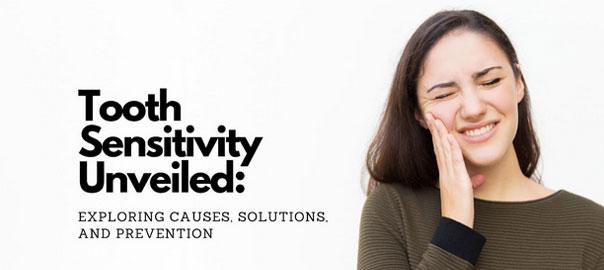
Sensitive Teeth: Causes, Treatment, and Prevention
Sensitive teeth can cause discomfort and pain, making it difficult to enjoy everyday activities like eating and drinking. If you experience a sharp, temporary sensation in your teeth when consuming hot or cold foods or beverages, you may be suffering from tooth sensitivity. In this blog post, we will explore the causes behind sensitive teeth, effective treatment options, and preventive measures to help you find relief and maintain a healthy smile.
Causes of Sensitive Teeth
Several factors can contribute to tooth sensitivity. Understanding the causes can help you identify potential triggers and manage the condition effectively. Here are some common culprits:
- Tooth enamel erosion: Enamel erosion occurs due to excessive brushing, tooth grinding, or consumption of acidic foods and drinks. It exposes the underlying dentin, a porous layer that contains microscopic tubules leading to the tooth’s nerve center, resulting in sensitivity.
- Gum recession: Receding gums expose the tooth roots, which lack the protective enamel covering found on the crowns. This exposes the dentin, making the teeth more sensitive to temperature changes.
- Tooth decay: Cavities or tooth decay can lead to sensitivity. When the decay reaches the inner layers of the tooth, it can irritate the nerves and cause sensitivity.
Treatment for Sensitive Teeth
Fortunately, various treatment options are available to alleviate tooth sensitivity and restore comfort. Here are some effective methods:
- Desensitizing toothpaste: Specially formulated desensitizing toothpaste contains compounds that help block the nerve sensations in the teeth. Regular use can reduce sensitivity over time.
- Fluoride treatments: Professional fluoride applications at the dentist’s office or using fluoride-rich toothpaste can strengthen tooth enamel, reducing sensitivity.
- Dental bonding or sealants: In cases of severe sensitivity, your dentist may recommend bonding or applying dental sealants to cover exposed root surfaces and protect them from external stimuli.
- Dental procedures: In some instances, dental procedures like root canal therapy, dental crowns, or gum grafts may be necessary to address underlying issues causing sensitivity.
Prevention of Sensitive Teeth
Preventing tooth sensitivity is possible with proper oral care and a few lifestyle adjustments. Consider the following preventive measures:
- Gentle brushing technique: Use a soft-bristled toothbrush and gentle circular motions to clean your teeth. Avoid applying excessive force, which can lead to enamel wear.
- Use a desensitizing toothpaste: Incorporate a desensitizing toothpaste into your oral hygiene routine to help reduce sensitivity.
- Limit acidic foods and drinks: Acidic substances like citrus fruits, sodas, and sports drinks can erode enamel. Minimize consumption and rinse your mouth with water afterward.
- Wear a mouthguard: If you grind your teeth at night, wearing a custom-fitted mouthguard can protect your teeth from damage and prevent enamel erosion.
- Regular dental check-ups: Schedule routine dental visits for professional cleanings and comprehensive examinations to identify and address potential issues early on.
Conclusion
Tooth sensitivity can be a source of discomfort, but with proper understanding, treatment, and preventive measures, you can manage the condition effectively. By identifying the causes and implementing the suggested remedies and preventive steps mentioned in this article, you can regain your ability to enjoy your favorite foods and beverages without pain.
Remember, it’s essential to consult a dentist at a dental clinic near you to determine the underlying cause of your sensitivity and develop a personalized treatment plan for your specific needs. With consistent care, you can maintain a healthy smile and prevent future sensitivity issues.
Leave a Reply
Leave a Reply
Explore More Similar Posts
Explore More Blogs


Leave a Reply